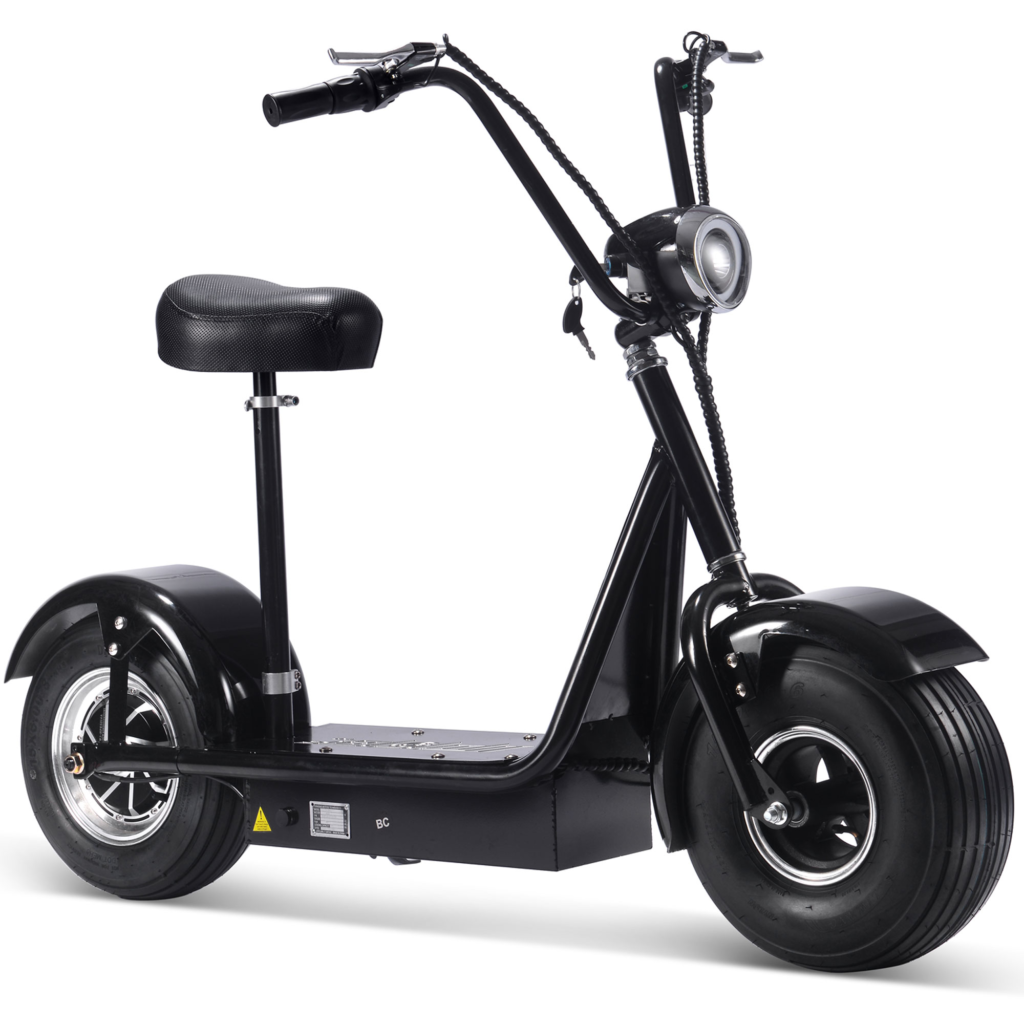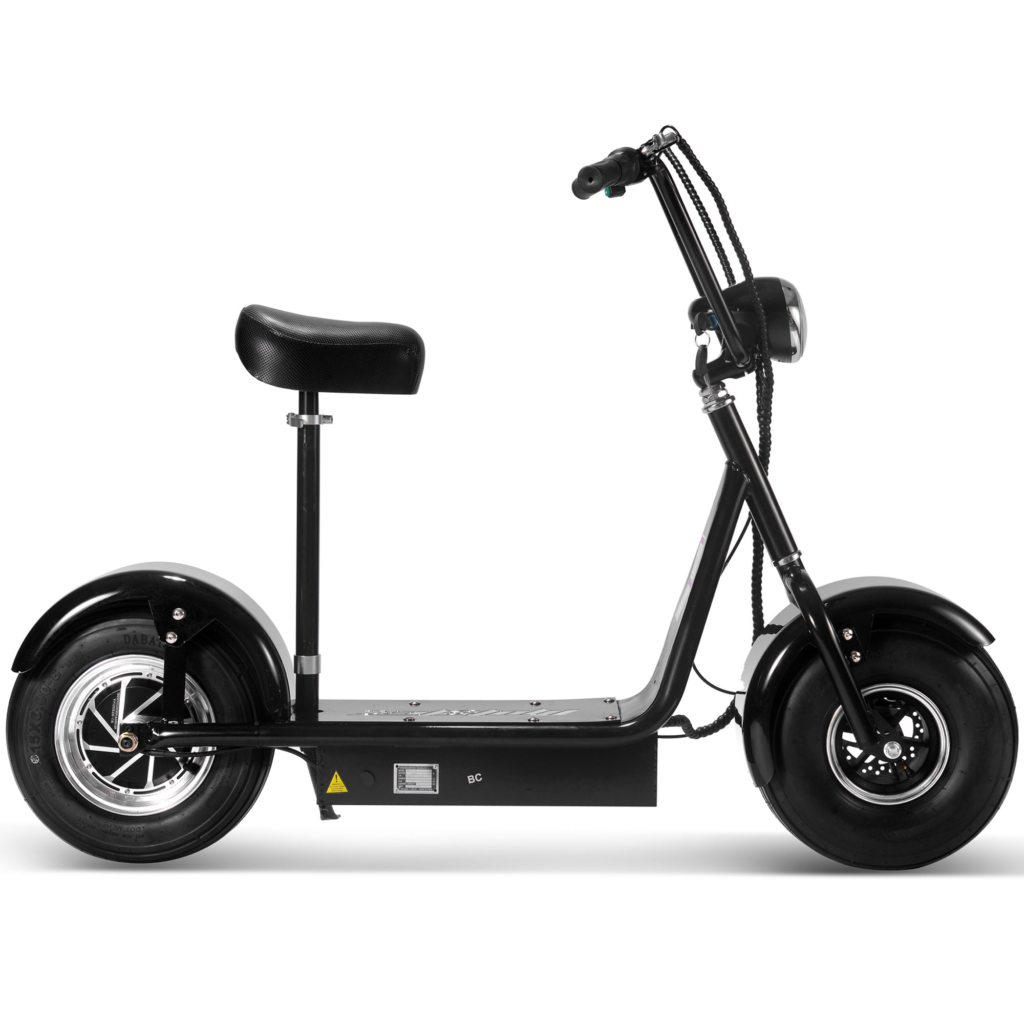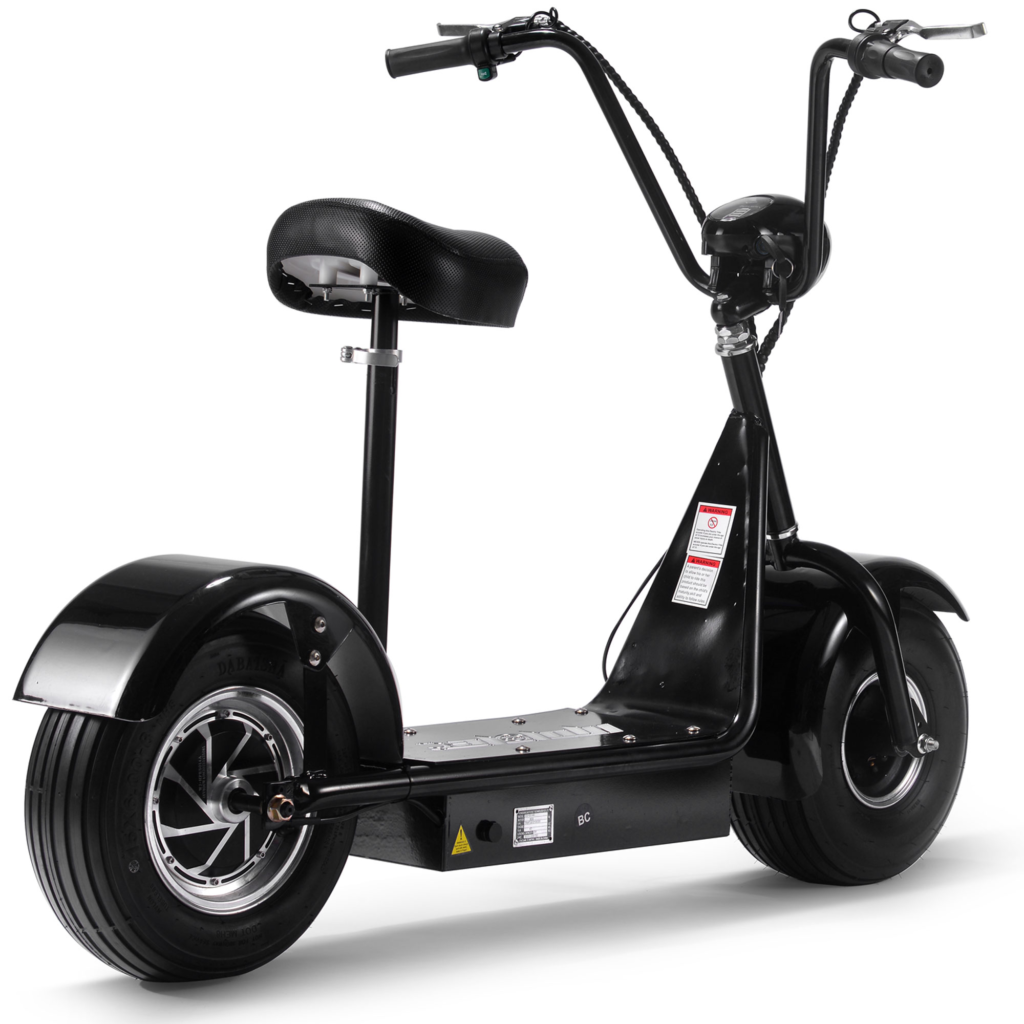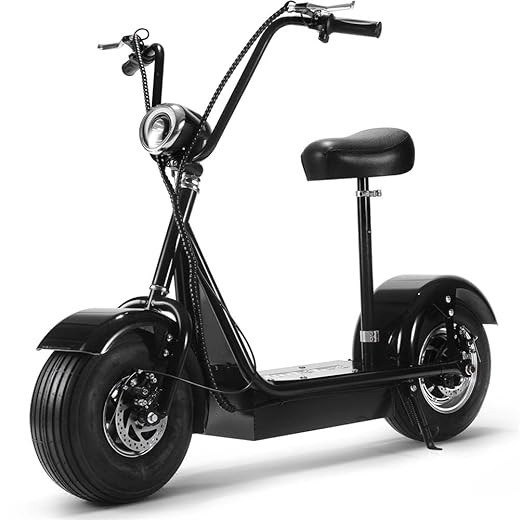Key Takeaways
- The MotoTec FatBoy Review highlights its comfort, control, and suitability for relaxed neighborhood rides.
- It features a stable ride with large pneumatic tires, basic speed modes, and mechanical brakes for better control.
- Expect a range of 5 to 15 miles per charge, depending on various factors like rider weight and terrain.
- Though it’s not foldable, the scooter’s sturdy build makes it ideal for ground-level storage and easy daily use.
- Overall, the MotoTec FatBoy offers a calm cruising experience for short trips but lacks features like an app or rain protection.
The MotoTec FatBoy is a big-tire, seated scooter that favors comfort and control. This MotoTec FatBoy review walks through design, power, range, and day-to-day use, so you can see where it fits. You get a relaxed ride and simple controls without a learning curve. For quick context, the MotoTec FatBoy targets slow, predictable trips on neighborhood streets and private paths.
Key Specifications
The table groups the official specs into clear blocks, and it highlights what shapes real-world performance and care. I refer to the official specifications again in the notes below.
| Block | Item | Details |
|---|---|---|
| General | Model | MotoTec FatBoy 48V 800W (fat-tire seated scooter) |
| Intended use | Recreation and short trips on smooth paths and neighborhood streets | |
| Rider height range | Works best for average to tall riders because of wide bars and seat height | |
| Max rider weight | 250 lb (113 kg) | |
| Performance & Power | Motor | 800 W rear hub motor, 48 V system |
| Speed modes | 3 modes: 5 mph, 10 mph, 18 mph (8, 16, 29 km/h) | |
| Claimed top speed | 18 mph (29 km/h) in the highest mode | |
| Climbing ability | Short hills around 10° | |
| Charging & Electrical | Battery | Four 12 V 12 Ah sealed lead-acid batteries, 48 V total |
| Charger | Wall charger with standard profile | |
| Charge time | 4–8 hours from low to full | |
| Lighting | Large front headlight | |
| Build & Dimensions | Overall size | 54 × 11 × 41 in (L × W × H) → 137 × 28 × 104 cm |
| Handlebar width | 30 in (76 cm) | |
| Seat height | 32 in (81 cm) from ground | |
| Ground clearance | 3 in (7.6 cm) | |
| Tires | Front 15×6.00-6 pneumatic, rear 15×6.00-8 pneumatic | |
| Frame | Steel frame with wide deck and mounted seat | |
| Folded dimensions | Not foldable | |
| Safety & Control | Brakes | Front and rear mechanical brakes |
| Traction | Fat tires for slow-speed grip and stability | |
| Visibility | Front headlight; add reflectors if local rules call for it | |
| Water resistance | No stated rating; avoid heavy rain and puddles | |
| Features & Extras | Speed selector | Handlebar switch for 3 speed caps |
| Display | Basic power and mode indicators | |
| Kickstand | Yes | |
| Cruise Control | No | |
| Warranty & Compliance | Warranty | 30-day parts replacement policy noted by the brand |
| Compliance | CEC for sale in California; brand notes UL 2272 for e-products 13+ |
Design & Build Quality
The FatBoy looks friendly and a bit bold. Those chunky tires pull the eye first, and they set the tone for the ride. They add a planted feel on flat ground, and they soften small cracks and seams. The deck sits low and long, so stepping on and off feels easy. The seat spreads weight between your legs and your hips, and that helps new riders relax.
Wide bars give you plenty of leverage at low speed. You notice the size in tight spaces, but the scooter prefers smooth arcs and calm turns. Sharp U-turns need room. The steel frame feels sturdy at neighborhood pace, and steering stays steady in a straight line.
Seat height sits at about 32 inches. Most adults feel fine there. Taller riders still get a relaxed knee angle. Shorter riders can slide forward a touch at stops and keep both feet down. The deck is wide enough for a natural stance, and there is enough grip underfoot to keep shoes put.
Fit and finish match the class. Welds look sturdy. Panels sit flush. Nothing flashy here, and the wiring is simple and easy to trace. You can open the deck cover and reach the battery pack for checks or swaps. That keeps fixes straightforward.
The frame does not fold, and the bars stay fixed. That choice adds rigidity and cuts play at the stem, and it helps the scooter track straight. It does make storage harder in small homes. A garage or ground-floor shed is ideal. Stairs are not fun with this one.

Motor, Power & Acceleration
Power comes from an 800 W rear hub motor. Delivery feels smooth, and the throttle avoids sudden jumps. Three speed caps keep things controlled. Mode one moves at a walking pace. Mode two feels like a steady jog. Mode three runs near 18 mph on level ground.
From a stop, the scooter pulls with calm intent. It does not snap forward. It builds speed at a steady rate, and that suits paths, shared driveways, and quiet streets. If you want a quick launch, this is not that machine. It behaves like a cruiser.
On slight hills, mode three holds speed if you arrive with a little momentum. On longer grades around 7–8 percent, it slows, and you settle into a patient climb. Big tires help grip over rough patches, and they add rotating mass, so they smooth short surges and dips.
Noise stays low. You hear a soft whir and some tire sound. There is no chain and no belt to adjust, so one regular chore drops off your list.
Battery, Range & Efficiency
The pack uses four 12 V 12 Ah sealed lead-acid batteries wired for 48 V. SLA packs add weight, and they like frequent charging. Plan to plug in after each ride. Keep the pack topped up if the scooter sits for a while.
Expect 5 to 15 miles per charge, which is about 8 to 24 km. Range depends on rider weight, terrain, speed mode, tire pressure, and temperature. A 180 lb rider rolling along at 10–12 mph on level ground should land in the middle. If you climb often or stay pinned in mode three, you will sit near the low end. Cold weather trims range, and strong headwinds do too.
If you want longer outings, plan a charge at your destination. Drop to mode two when range anxiety creeps in, and you will stretch miles. Proper tire pressure makes a real difference here. Soft tires waste energy and dull the steering. Check pressure weekly and follow the brand’s guidance.
As the pack ages, the usable window shrinks. SLA chemistry responds well to full charges and shallow discharges, so avoid running it flat if you can. Store the scooter indoors in a cool, dry place.
Ride Quality, Handling & Comfort
Ride feel is the headline. Those large pneumatic tires soak up a lot of the small chatter from rough asphalt. You still feel square-edge hits, but the sting drops. The seat takes the edge off, and you can rise slightly over ruts if you want to save your back. The long wheelbase adds calm on straight lines and through wide turns.
At the 18 mph cap, the scooter prefers steady inputs. The wide bar and big front contact patch add a bit of self-centering feel, and that helps you hold lines. Quick flicks work better at low speed. On broken asphalt, the fat tires track with confidence. Hard-packed gravel rides fine if you keep the pace sensible. Loose gravel needs care, so ease off and steer gently.
The upright posture reduces strain on wrists and neck. The saddle foam is firm, and it stays comfortable over the short runs this scooter invites. The deck gives enough space to shift your stance. You can plant both feet forward or stagger them. Bar buzz stays low on typical suburban roads.
Noise stays in the background. Wind and tire rumble grow past 12 mph, and that is about it. Grass rides are easy at low speed, though wet grass changes grip fast, so slow down and go easy on the brakes.
Braking & Safety Features
Front and rear mechanical brakes handle stopping. Lever feel is direct, and modulation is easy at neighborhood speeds. On clean pavement, the scooter slows in a straight line and does not feel jumpy. Panic stops still need room, so look farther ahead and keep space around you. For long downhills, use short squeeze bursts to keep speed in check.
The front headlight helps you see and be seen at dusk. It lights the area right in front of the wheel. It does not take the place of a bright night setup for road riding. Add a rear light or reflectors if cars share your route. There is no water rating, so skip heavy rain and standing water. Wet brakes take longer to bite, and splash into the battery bay is not great for longevity.
Wide tires add a margin on poor surfaces. They spread weight and resist pinch flats better than skinny tires. Sand and loose gravel still demand care, so enter corners slowly and straighten the bike before you brake.

Portability & Daily Usability
This is not a commuter you toss in a trunk. The frame and bars do not fold. The big tires take space, and tight hallways feel tight. Plan ground-level storage. A garage, shed, or covered patio is the easy answer. The kickstand is sturdy and holds the scooter upright on flat ground.
Carrying it up stairs is a chore. A pickup bed or a small ramp helps if you must transport it often. For apartment life above the first floor, think twice. For a house with a driveway, it is simple. Roll out, ride, and roll back.
Daily use is clean and quick. Turn the key, pick your mode, and go. Check tire pressure, and you will get better ride and range. Wipe it down after dusty loops, and keep contact points clean. The hub motor means no chain oil, and that is one less thing to worry about.
Features, App & Extras
The FatBoy keeps things simple. You get a headlight, a speed-mode selector, and basic indicators for power and mode. There is no app. There is no Bluetooth or phone pairing. There is no cruise control. Fewer systems mean fewer distractions and fewer repairs.
The seat is the real quality-of-life add. Rolling at 10–12 mph feels easy on your back and knees, and you can sit upright and keep your head up. The big tires do the rest and smooth the constant chatter of rough pavement.
Charging Experience & Maintenance
A full charge takes 4 to 8 hours. The exact time depends on how low the pack sits and the room temperature. The charger is simple. Seat the plug fully, then let it finish its cycle. Short top-offs all week are not ideal for SLA packs, so plan real charge sessions.
Quick checks go a long way. Look at brake pads and cables every few weeks. Squeeze the levers before rides and make sure travel feels normal. Keep bolts on the bars and seat tight. Watch tire pressure. Store the scooter indoors and out of the sun. If you open the deck cover, clean dusty edges first to keep grit out of the bay.
If range drops fast, the pack may be reaching the end of its life. SLA batteries have a finite cycle count. A fresh set brings range back, and most shops can handle the swap. If you do it yourself, follow the manual, label leads, and take your time. Then check all fasteners again before riding.
Who the MotoTec FatBoy Is For
Pick the FatBoy if comfort beats speed on your list. It suits beach towns, gated communities, RV parks, college campuses, and large private properties. The seated layout and big tires make short trips simple and low stress. New riders tend to like that steady feel. Prefer a leaner city runabout with a smaller footprint? The MotoTec Metro takes a different approach and fits tighter spaces.
Skip it if you need a folding commuter for stairs or small trunks. The size fights you there. If you want quick acceleration or long range, look at a lighter lithium scooter with a stronger motor. If you plan to ride in rain, shop for a model with a clear water rating.
For the job it was built to do, the FatBoy makes sense. It turns local travel into a calm, easy routine.

MotoTec FatBoy review: Value for Money & Verdict
Value lives in the ride feel and the simple build. Big tires and a seat deliver comfort that small-wheel scooters struggle to match. The motor is modest, and the three speed caps let you set a pace for shared paths. Common battery parts keep service simple. The hub motor trims the upkeep list. You give up range and portability, and you get stability and low fuss.
So where does that leave you. If most trips stay under 10 miles round-trip and you have ground-level storage, the FatBoy fits well. If you want a calm cruiser for neighborhood loops, it checks the box. If you need a fast commuter that folds, this is not it. Set the right expectations, and it does what it promises.
And yes, the big tires help more than you might expect. They flatten cracks, add grip on dusty corners, and reduce stress when surfaces change. Confidence grows as you ride, and that makes short trips feel easier and safer.
Pros & Cons
Pros
- Stable, planted ride from large pneumatic tires
- Relaxed seated posture for short trips
- Simple three-mode speed selector for controlled pacing
- Smooth throttle response that suits new riders
- Mechanical brakes with clear lever feel
- Easy access to the battery bay for service
- Wide bars improve leverage and slow-speed control
Cons
- Non-folding frame is hard to store in small spaces
- Short real-world range versus lithium scooters
- Heavy SLA pack needs frequent top-offs
- No rear light and basic visibility package
- No app, no screen, and no cruise control
- Not built for rain or heavy splash
- Tight U-turns require space
Price
FAQs
How fast does the MotoTec FatBoy go?
You get three caps. Mode one lands near 5 mph. Mode two sits around 10 mph. Mode three reaches about 18 mph on level ground.
What range can I expect on one charge?
Plan for 5 to 15 miles, or about 8 to 24 km. Rider weight, terrain, speed mode, tire pressure, and temperature all play a role.
Is this MotoTec FatBoy review helpful for light gravel paths?
Yes. The fat tires keep traction at modest speeds on firm gravel. Slow down on loose sections and turn gently.
Can I ride it in the rain?
There is no water rating. Light mist is one thing, but heavy rain and puddles are not advised. Store it dry.
Does it fold for storage or car travel?
No. The frame and bars do not fold. Ground-level storage works best. For transport, a ramp or pickup bed helps.
What maintenance should I plan for?
Charge after rides, keep tires at proper pressure, check pads and cables, and tighten bolts now and then. Replace the SLA pack when range falls off.
Does it have cruise control or an app?
No. Controls stay simple with a speed selector and basic indicators.
Final Notes on Setup and Care
Set tire pressure before the first ride. Charge the pack fully, then test all three modes on a safe, flat loop. Keep a short log of ride time and charge time for the first few weeks, so you can spot changes early. Store it clean and dry. If you pause riding for a month or more, top up the pack every few weeks.



